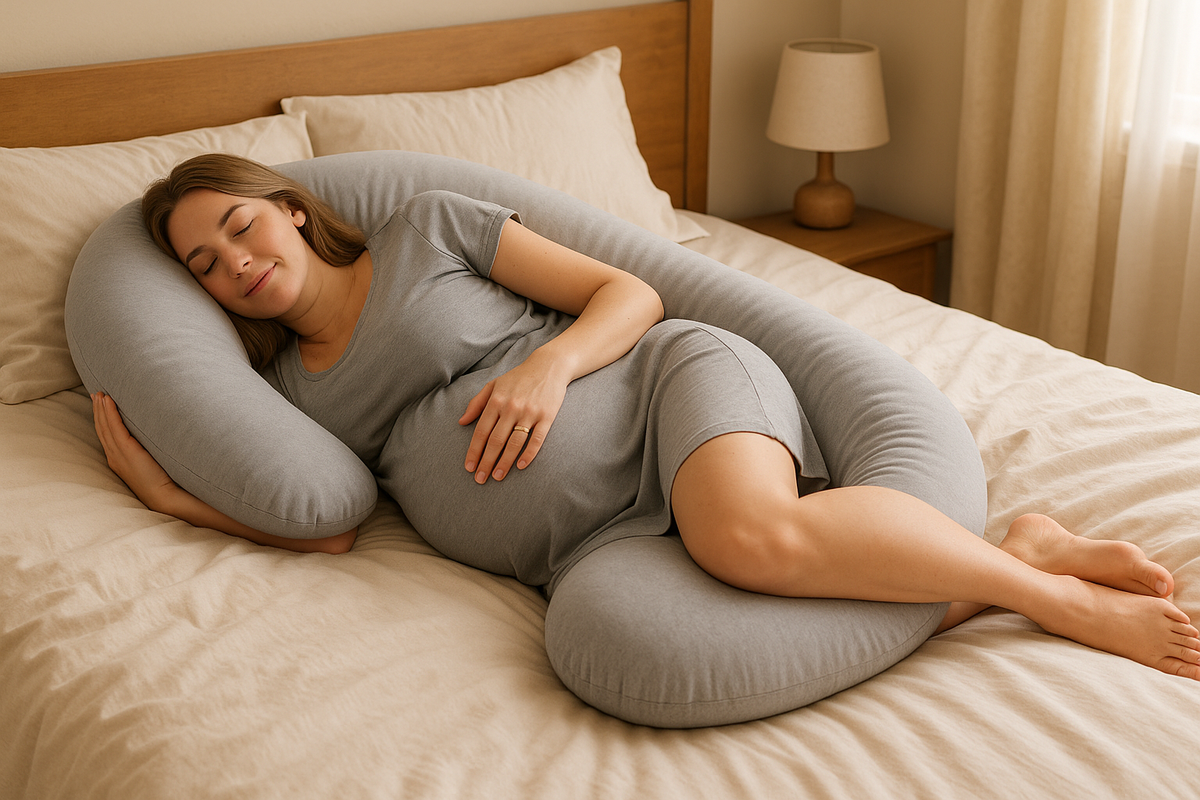
Is Back Sleeping Safe During Pregnancy?
|
|
Tijd om te lezen 5 min

Sleep is essential for our well-being, and we understand that a good...
|
|
Tijd om te lezen 5 min
One of the most common concerns expectant mums raise is whether it’s safe to sleep on their back during pregnancy. For many, back sleeping has always felt natural and comfortable. But pregnancy brings new changes to your body, and even the way you sleep may need to adjust. Health experts, including the NHS and the American College of Obstetricians and Gynecologists (ACOG), generally recommend side sleeping in the second and third trimesters. Still, the advice can feel confusing and even worrying if you keep waking up on your back at night.
This article explores what the research says, why back sleeping can be risky later in pregnancy, and how you can adapt gradually to side sleeping. You’ll also discover practical tips, FAQs, and the role of specialist pregnancy pillows in keeping you comfortable. If you’re already trying to change your habits, you may also find our step-by-step guide to transitioning to side sleeping especially useful.
Lying flat on your back in mid-to-late pregnancy can place the full weight of your growing uterus on major blood vessels and organs. The main concern is compression of the inferior vena cava — the large vein that carries blood from the lower body back to the heart. This pressure can:
Research from both the UK and New Zealand shows a clear link between back sleeping after 28 weeks and increased risk of stillbirth. The large MiNESS study in the UK found that women who went to sleep on their backs had a 2.3-fold higher chance of late stillbirth compared with those who went to sleep on their side
Similarly, a multi-national study led from New Zealand and the University of Auckland confirmed that going to sleep on your back after 28 weeks more than doubled stillbirth risk, independent of other factors (<a
Physiological studies from UCL London also support this, showing that back sleeping reduces blood flow to the uterus and placenta (<a
While the overall risk is still low, NHS and New Zealand’s Health service both recommend side sleeping from 28 weeks as the safest choice.
Each sleep position has pros and cons during pregnancy. Here’s a quick comparison:
| Position | Pros | Cons |
|---|---|---|
| Back | Familiar and comfortable for some women | Can restrict blood flow, worsen reflux and back pain, and is not advised after ~20 weeks |
| Side (Left) | Best for circulation and oxygen flow; relieves pressure on spine and organs | May feel awkward at first; often requires pillows for support |
| Side (Right) | Safe and comfortable variation | Slightly less optimal for circulation than left side |
| Stomach | Usually safe and comfortable early in pregnancy | Becomes uncomfortable and impractical as bump grows |
Want to dive deeper into side sleeping? Read our practical guide on how to make the switch safely. You can also explore more in Body Pillow Uses: Why You Need One in Pregnancy.
If you’re struggling to break the habit of back sleeping, consider these safer alternatives:
Explore our full pregnancy pillow collection and pair them with washable pillowcases for lasting comfort.
Changing your natural sleep position takes time. Here are a few gentle strategies:
For a detailed approach, see our guide on transitioning to side sleeping.
What if I wake up on my back?
Don’t panic. Brief periods are not usually harmful. Simply roll back onto your side when you notice. Learn how to stay on your side in our side sleeping guide.
Can back sleeping cause stillbirth?
Some studies show a possible link between back sleeping after 28 weeks and stillbirth. While the risk is considered small, experts recommend side sleeping as a precaution.
Is it okay to sleep propped up on my back?
Yes. If you’re on a slight incline, pressure on blood vessels is reduced. Recliner chairs and adjustable beds are often used safely in late pregnancy.
What if I can’t sleep on my side?
Experiment with different pillow setups — U-shaped, C-shaped, or wedges. Many mums find these help them stay in position comfortably. See our pregnancy pillows.
Which side is best?
The left side is recommended for optimal blood flow and kidney function. But right-side sleeping is still safe. The main goal is avoiding flat back sleeping in later pregnancy.
Does sleeping partially upright count as back sleeping?
No. If your upper body is elevated at about 30 degrees, you’re not lying flat, so the main risks are avoided.
Can I use a recliner chair to sleep?
Yes, many women find recliners a comfortable option in late pregnancy. Just ensure your torso is slightly upright, not completely flat.
Back sleeping is generally safe in the first trimester, but from around 20 weeks, experts recommend switching to side sleeping. Side sleeping, especially on the left, supports circulation, reduces discomfort, and lowers risks for both mother and baby. With the right pillows and gradual adjustments, you can retrain your body to rest comfortably without worrying about your sleep position.
For extra comfort and support, explore our pregnancy pillow collection and read our step-by-step guide to transitioning to side sleeping.
Disclaimer: This article is for informational purposes only and not a substitute for professional medical advice. Always consult your doctor or midwife for personalised guidance.